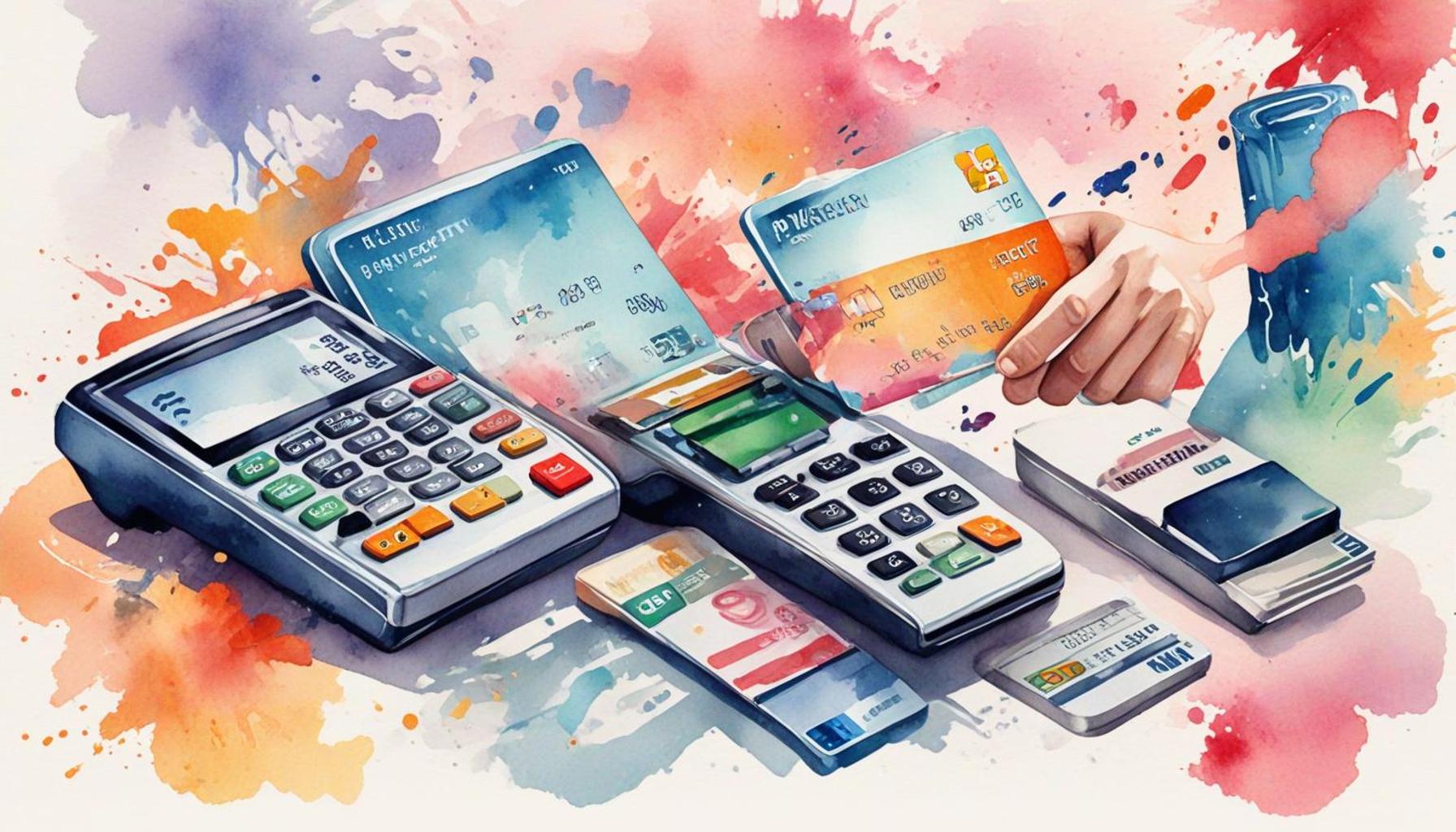How Payment Technology in the USA is Changing the Way We Consume

Transformative Trends in Consumer Payment Methods
The rapid evolution of consumer payment methods in the United States signifies a pivotal moment in both commerce and technology. The advancement in payment technology has not only altered the mechanics of financial transactions but has also significantly impacted how consumers view and manage their spending. This transformation is characterized by several key trends that collectively offer heightened convenience and improved transaction efficacy.
Digital Wallets: The Rise of Mobile Payments
Digital Wallets, such as Apple Pay and Google Wallet, have revolutionized how payments are processed. These tools allow users to store multiple credit and debit cards digitally, facilitating quick and secure transactions directly from their smartphones. For instance, during a trip to retail stores, consumers can simply tap their device at checkout instead of rummaging through their wallets for physical cards. Furthermore, digital wallets often store loyalty rewards and discounts, creating a comprehensive shopping experience that prioritizes consumer convenience.
Contactless Payments: Speed and Security
The emergence of Contactless Payments has also gained traction, driven by technology like Near Field Communication (NFC). This system enables users to make swift transactions by merely tapping their cards or devices against a compatible terminal, significantly reducing wait times. For example, many transit systems in major US cities, including New York and San Francisco, have incorporated contactless payment systems, allowing commuters to pay fares quickly without the need for cash or traditional ticket purchasing.
Cryptocurrency Adoption: A New Financial Frontier
Another significant factor is the growing Cryptocurrency Adoption among retailers. As digital currencies like Bitcoin and Ethereum gain legitimacy, a broader array of businesses has started accepting them as a form of payment. This allows consumers to leverage their digital assets while expanding payment options. For instance, a consumer might choose to make an online purchase with cryptocurrency for its potential advantages in transaction fees and privacy.
Buy Now, Pay Later (BNPL): Flexibility in Spending
The rise of Buy Now, Pay Later (BNPL) services, exemplified by platforms like Afterpay and Klarna, has further transformed consumer spending behavior. This option allows consumers to acquire products immediately while paying for them in manageable installments. It offers significant benefits, particularly for high-ticket items, as it enhances accessibility and reduces the financial strain tied to large purchases. For example, a consumer looking to buy a new smartphone can split the cost into digestible monthly payments rather than dealing with a substantial upfront expense.
In summary, the evolution of payment technology has ushered in an era of enhanced convenience, increased options, and more informed purchasing decisions. As consumers adapt to these innovative methods, businesses must remain cognizant of these trends and work to align their strategies, ensuring they meet the evolving demands and expectations of the modern consumer landscape. This understanding is imperative for businesses aiming to thrive in an ever-changing economic environment.
SEE ALSO: Click here to read another article
Innovative Payment Solutions Transforming Consumer Behavior
The impact of innovative payment solutions on consumer behavior in the United States cannot be overstated. These advancements are redefining not only the transactional landscape but also influencing how consumers approach their purchasing decisions. With an increasing reliance on technology, consumers are now navigating a rich array of financial tools that encourage smarter spending and prompt decision-making.
Mobile Banking and App Integration
The rise of mobile banking apps has significantly empowered consumers to manage their finances more efficiently. These applications provide users with real-time access to their accounts, enabling them to track spending patterns, set budgets, and even receive personalized financial advice. For instance, services like Mint and Personal Capital allow users to categorize their expenses, helping them identify areas for potential savings. As a result, consumers are more informed about their financial health, leading to conscious spending choices that align with their individual financial goals.
Enhanced Security Features
In tandem with the rise of payment technology, enhanced security measures have also become paramount. Biometric authentication practices, such as fingerprint scans and facial recognition, are increasingly integrated into payment systems. These features help mitigate fraud risks, instilling greater confidence among consumers when using digital platforms. According to a report from the Federal Reserve, approximately 85% of US consumers express concern regarding online transaction security, making these advancements crucial in maintaining trust in digital spending.
Subscription-Based Payment Models
Another trend that has gained substantial traction is the subscription-based payment model. This model, which allows consumers to pay a recurring fee for access to services or products, is now commonplace across various industries, from entertainment platforms like Netflix to monthly subscription boxes for beauty products. This payment structure not only promotes loyalty but also encourages consumers to engage with brands on a more consistent basis. In fact, a recent survey indicated that nearly 60% of consumers in the United States have at least one active subscription service, showcasing a shift in spending behaviors towards convenience and regular consumption.
OMS and Real-Time Transaction Tracking
Lastly, the integration of Order Management Systems (OMS) has enhanced the consumer experience by providing real-time transaction tracking. These systems enable consumers to receive instant updates on their purchases, which fosters transparency in the buying process. Features such as tracking numbers and estimated delivery dates empower consumers with information, allowing them to make informed decisions regarding their purchases. A study by McKinsey & Company found that 70% of consumers are more likely to make repeat purchases from brands that offer reliable tracking capabilities.
In essence, the advancements in payment technology are reshaping consumer behaviors by promoting informed decision-making, enhancing security, and encouraging a subscription-driven economy. As these technologies continue to evolve, understanding their implications on consumer consumption patterns will be vital for businesses aiming to adapt effectively in this fast-paced environment.
SEE ALSO: Click here to read another article
The Rise of Digital Wallets and Contactless Payments
The evolution of digital wallets has emerged as a significant factor in altering consumer spending habits in the United States. Platforms such as Apple Pay, Google Pay, and Samsung Pay have transformed traditional payment methods by allowing consumers to store multiple payment options in one convenient application. With the ability to link credit cards and bank accounts directly to their smartphones, consumers can complete transactions with just a tap or swipe. This convenience not only simplifies the purchasing process but also accelerates consumer decision-making, as it reduces the friction typically associated with cash or card transactions.
Empowering Consumer Choice through Loyalty Programs
Digital wallets often include loyalty programs that reward consumers for frequent purchases. Integrating these loyalty programs directly into payment platforms encourages consumers to choose specific retailers based on reward incentives. The American Express 2020 Customer Loyalty Survey revealed that 61% of consumers are more likely to shop at businesses that offer loyalty rewards. By gamifying the shopping experience, these programs foster increased consumer engagement and motivate individuals to remain committed to preferred brands. Furthermore, as consumers become more adept at utilizing these rewards, they are less inclined to compare prices, often leading to impulsive purchasing behaviors.
The Impact of E-commerce on Spending Patterns
The rise of e-commerce has redefined consumer purchasing dynamics, particularly through the integration of payment technologies. One-click purchasing, made popular by platforms like Amazon, allows consumers to bypass traditional checkout processes that often induce hesitation or cart abandonment. Research by Barilliance indicated that nearly 70% of online shopping carts are abandoned, emphasizing the crucial role that seamless payment systems play in influencing final purchasing decisions. By streamlining the online shopping experience, payment technologies reduce friction and encourage instant purchases, shaping a landscape where impulse spending is increasingly prevalent.
Cryptocurrency and the Future of Payments
Additionally, the burgeoning use of cryptocurrency is poised to further revolutionize consumer finance in the USA. Payment solutions that accept digital currencies like Bitcoin, Ethereum, and others are gaining traction among a tech-savvy demographic. This trend not only caters to consumers’ desires for innovative payment methods but also introduces a new set of transactions that bypass traditional banking systems. According to a recent survey by Pew Research, about 16% of Americans have invested in or used cryptocurrency, reflecting a growing acceptance of these digital assets as a legitimate payment method. This evolution represents a shift towards decentralized financial systems and offers consumers greater control over their spending practices.
Social Media Integration and Instant Payments
The integration of payment technology into social media is also influencing consumer purchasing behavior. Platforms such as Facebook and Instagram now enable users to buy products directly through their feeds, integrating shopping with social engagement. By combining elements of social proof with instant payment options, these platforms capitalize on the impulse-driven nature of consumer behavior. A strategic McKinsey report indicated that approximately 30% of consumers prefer to shop through social media, underscoring how these platforms are reshaping traditional buying practices. The seamless connection between social engagement and commerce is creating an environment where consumers feel empowered to purchase on impulse.
As these diverse payment technologies gain traction, they collectively reshape how consumers interact with brands, further emphasizing the need for businesses to adapt swiftly to these evolving behaviors. The infusion of digital solutions is not merely altering transaction methods; rather, it’s redefining the entire consumer experience in an increasingly tech-oriented marketplace.
CHECK OUT: Click here to explore more
Conclusion
The rapid evolution of payment technology in the United States is profoundly reshaping how consumers engage with brands and make purchasing decisions. Digital wallets, a prominent innovation, have streamlined transactions, allowing users to make payments swiftly with just their smartphones. This advancement not only enhances convenience but also leads to a shift towards impulsive buying behaviors, as evidenced by the significant rise in one-click purchasing options seen in e-commerce platforms.
Moreover, loyalty programs integrated into these payment methods play a critical role in driving consumer choices, encouraging brand loyalty based on reward incentives. As consumers become increasingly reliant on technology-driven solutions, businesses must adapt to meet these changing preferences and expectations. The integration of cryptocurrencies into payment systems further signals a transformative trend, granting consumers more control over their transactions and paving the way for decentralized financial interactions.
Additionally, the burgeoning influence of social media platforms as a direct avenue for purchasing illustrates the convergence of social engagement and commerce. With approximately 30% of consumers favoring social shopping, brands must embrace this trend to capitalize on consumer behavior shaped by instant gratification and social proof.
In summary, payment technology is not just altering transaction methodologies but is fundamentally redefining the entire landscape of consumer behavior in the USA. To thrive in this dynamic environment, businesses must remain agile, continuously innovating their payment solutions and ensuring that they resonate with the evolving desires of the modern consumer.
Related posts:
What Happens to the Stock Market During Economic Crises?
How to Protect Your Finances During an Economic Crisis
The Impact of Social Media on Investment Decisions in the Stock Market
How Big Companies Influence the Stock Market and the Economy
How to declare foreign investments on US income tax
Comparison between the best traditional and digital banks in the USA

Beatriz Johnson is a finance and investment professional with a strong passion for writing. With a solid educational background in finance and investments, she combines her expertise with a talent for simplifying complex financial concepts. Through her work on Oracle Life Sciences Inform, Beatriz educates and empowers readers by providing valuable insights into wealth management, smart investing, and financial planning, helping them make informed decisions for a secure and prosperous future.